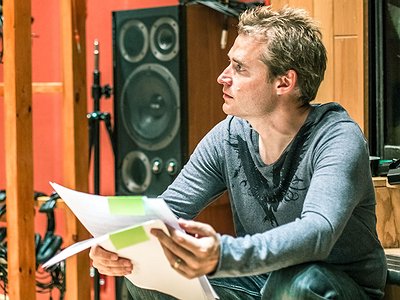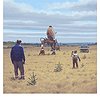Part 1
Name: Paul Leonard-Morgan
Nationality: British
Occupation: Composer
Current Release: Tales From the Loop (Original Soundtrack)
Recommendation: Simon Stahlenhag – Tales From The Loop. I have just finished scoring the series, but I was never really aware of Simon’s art (which the series was based on) and it’s without doubt some of the most powerful and thought-provoking images I’ve ever seen / Yo Yo Ma’s version of Thaïs: Meditation. It’s what the world needs right now.
Website/Contact: Keep up to date with Paul's work on his website www.paulleonardmorgan.com
When did you start composing film and TV music - and what or who were your early passions and influences? What is about music and/or sound that drew you to it?
I remember the first piece that I wrote was when I was aged 12 at a school concert with a Yamaha synthesizer and a awful drum machine, while I was playing the piano in the concert hall. My parents sat there, and everyone politely collapsed. My mum is a music teacher and I’d always heard her giving piano and flute lessons, so I was just surrounded by these wonderful sounds for as long as I can remember.
For most artists, originality is first preceded by a phase of learning and, often, emulating others. What was this like for you? How would you describe your own development as an artist and the transition towards your own voice? What is the relationship between copying, learning and your own creativity?
When I studied at the Royal Scottish Academy of Music and Drama, I would sit in the music library studying the scores of Bernstein and Copland, as I adored their music. Similarly, when I started working with bands, I would be listening to the fantastic arrangements of Lee Hazlewood and his work with Nancy Sinatra, as an example. So, I guess you can study these things and find out what it is that make them great. Then at some stage you have got to have your own style, so somewhere along the lines your experiments with sounds and styles which are other people’s have got to morph into your own style. That is what makes being a composer such a wonderful thing, your style gets better and finds new paths with experience.
What were your main compositional challenges when starting out as a film composer and how have they changed over time?
Starting out I think I was always a bit nervous of using my own creative voice, as I had not mastered my craft, so I was always trying to second guess what producers and directors might want. Now I think the challenge is more reigning myself in, sometimes, from being too avant-garde! where as a composer, we used to be able to use long melodies and had time to expand them over a film, it’s increasingly rare for that to happen. There’s less and less room for silence, with much more music going on, and the call is often for it to be denser and percussion-heavy, as people’s attention spans are less, if they’re watching tv, people have phones, social media to distract them, so producers are keen to keep them as on the hook as possible to their programme.
What, to you, are the main functions and goals of soundtracks and film/TV music and how would you rate their importance for the movie as a whole? How do you maintain a balance between, on the one hand, artistic integrity and sticking to your creative convictions and, on the other, meeting the expectations of the director?
I see the main function of a soundtrack as helping the film connect emotionally with the audience. I would say that it’s one of the most important things. A film can clearly work without music, but a good score can transform a film. As one of the last pieces of the jigsaw left to complete before it’s finished, there’s only so much that can be done – acting, editing and shooting have all finished, so sound is the last part of the process where the creative team can change their vision for their film. You also need to remember that this is their baby, the director has been living and breathing their film for years. It is only natural that producers, with all their money invested, will want to have a say, and there is often a dynamic between producers and directors. As a composer, it is important to come on and tell them to breathe, have some faith, and just let you do your thing for a while, to explore your vision. Then the collaboration comes, and it is a wonderful thing. You cannot be too precious with your ideas – there are some which will work great, some which need some shaping with the director’s help, and some which you need to bin. It is a team effort, but the most important thing is to believe in what you are creating. Do not just do people’s notes for the sake of it, take on board what they are saying, filter them all, and work out what it is they actually mean. For example, someone might tell you to add more drums, but what they actually mean is they need more energy, which you can create in a multitude of ways.
What was your first studio like? How and for what reasons has your set-up evolved over the years and what are currently some of the most important pieces of gear for you?
My first studio was a tiny corridor in the back of Cava Studios in Glasgow, the vocal booth was a sort of cupboard next to it, then you would walk through this cupboard to get to the toilet and it was freezing. I had Tascam DA88’s, an early mac, a Soundcraft mixing desk and a Korg 01W keyboard. I remember buying my first Akai S3200 with 8 megs of RAM. (Cost a fortune!). The filters on that thing were sick! Then gradually I’d just keep buying more gear and samples. I was skint, so ended up selling all my original 80’s keyboards which I now kick myself about! Gradually as I started getting more work, I then bought a house which I converted into a studio, and with technology evolving I got rid of the Tascam’s and just went straight into the box with Digital Performer. Now I have matching studios in Glasgow and LA. I spent a year building this one in LA and it is definitely my dream studio. I have got a 1200 square foot live room where my assistant also works, and my writing room is about 800 square feet. I have various macs and samples, but my go-to synhs at the moment are the Arturia MatrixBrute, My Folktek Mescaline which the other composers on Cyberpunk introduced me to, my Nord and TB 808 get regular workouts, too. And I just bought a 1975 Rhodes with suitcase amp, so am in heaven! I have Yahama C7 grand pianos at both studios.
How do you make use of technology? In terms of the feedback mechanism between technology and creativity, what do humans excel at, what do machines excel at?
I obviously use my computers every day for sequencing (Digital Performer and Vienna Pro on a slave PC are my essential Go-to’s). But I have increasingly found that it is so easy to become obsessed with producing the tracks as you go along, as opposed to concentrating on the quality of the composition itself. Philip Glass reminded me of this recently in our score to Tales from the Loop. I am getting better at just writing at the piano, rather than reaching straight for the strings or samples that are there at my fingers. Technology is great to get you where you want to go, it makes experimenting so fast, a reverse here, a delay there, a time stretch here, a warped plug-in here. But it takes time to create a totally unique sound and composition, so you have got to remove yourself from the cosy environment where you’re churning music out so quickly.
Production tools, from instruments to complex software environments, contribute to the compositional process. How does this manifest itself in your work? Can you describe the co-authorship between yourself and your tools?
Sample libraries are helpful in enabling you to get mock-ups done quickly and show people how things will sound, but they can also weigh you down if you spend too much time with them. Whereas I adore software VI’s, like Arturia, U-HE, etc, you can go so in-depth and create some really original sounds. I have a Keylab 61 and a Keylab 88, and I love the way that all the knobs interact seamlessly with the software, saving all the cc data, etc. And I use these keyboards to programme up all the other data for other VI’s and sample libraries.






